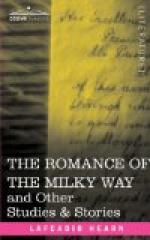One summer night, Hakuy[=o]—now immortally beautiful and young—descended from heaven upon her magpie, to visit her husband; and he was made very happy by that visit. But from that time he could think of nothing but the bliss of becoming a star, and joining Hakuy[=o] beyond the River of Heaven. At last he also ascended to the sky, riding upon a crow; and there he became a star-god. But he could not join Hakuy[=o] at once, as he had hoped;—for between his allotted place and hers flowed the River of Heaven; and it was not permitted for either star to cross the stream, because the Master of Heaven (Ten-Tei) daily bathed in its waters. Moreover, there was no bridge. But on one day every year—the seventh day of the seventh month—they were allowed to see each other. The Master of Heaven goes always on that day to the Zenh[=o]do, to hear the preaching of the law of Buddha; and then the magpies and the crows make, with their hovering bodies and outspread wings, a bridge over the Celestial Stream; and Hakuy[=o] crosses that bridge to meet her husband.
There can be little doubt that the Japanese festival called Tanabata was originally identical with the festival of the Chinese Weaving-Goddess, Tchi-Niu; the Japanese holiday seems to have been especially a woman’s holiday, from the earliest times; and the characters with which the word Tanabata is written signify a weaving-girl. But as both of the star-deities were worshiped on the seventh of the seventh month, some Japanese scholars have not been satisfied with the common explanation of the name, and have stated that it was originally composed with the word tan[’e] (seed, or grain), and the word hata (loom). Those who accept this etymology make the appellation, Tanabata-Sama, plural instead of singular, and render it as “the deities of grain and of the loom,”—that is to say, those presiding over agriculture and weaving. In old Japanese pictures the star-gods are represented according to this conception of their respective attributes;—Hikoboshi being figured as a peasant lad leading an ox to drink of the Heavenly River, on the farther side of which Orihim[’e] (Tanabata) appears, weaving at her loom. The garb of both is Chinese; and the first Japanese pictures of these divinities were probably copied from some Chinese original.
In the oldest collection of Japanese poetry extant,—the Many[=o]sh[=u], dating from 760 A.D.,—the male divinity is usually called Hikoboshi, and the female Tanabata-tsum[’e]; but in later times both have been called Tanabata. In Izumo the male deity is popularly termed O-Tanabata Sama, and the female M[’e]-Tanabata Sama. Both are still known by many names. The male is called Kaiboshi as well as Hikoboshi and Kengy[=u]; while the female is called Asagao-him[’e] ("Morning Glory Princess")[1], Ito-ori-him[’e] ("Thread-Weaving Princess"), Momoko-him[’e] ("Peach-Child Princess"), Takimono-him[’e] ("Incense Princess"), and Sasagani-him[’e] ("Spider




